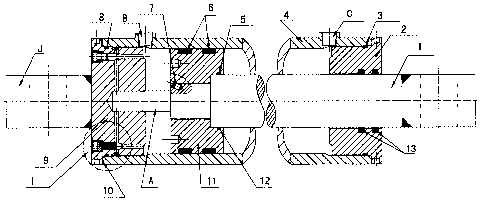Une partie des informations de ce site Web a été fournie par des sources externes. Le gouvernement du Canada n'assume aucune responsabilité concernant la précision, l'actualité ou la fiabilité des informations fournies par les sources externes. Les utilisateurs qui désirent employer cette information devraient consulter directement la source des informations. Le contenu fourni par les sources externes n'est pas assujetti aux exigences sur les langues officielles, la protection des renseignements personnels et l'accessibilité.
L'apparition de différences dans le texte et l'image des Revendications et de l'Abrégé dépend du moment auquel le document est publié. Les textes des Revendications et de l'Abrégé sont affichés :
| (12) Demande de brevet: | (11) CA 2557756 |
|---|---|
| (54) Titre français: | VERIN HYDRAULIQUE |
| (54) Titre anglais: | HYDRAULIC CYLINDER |
| Statut: | Réputée abandonnée et au-delà du délai pour le rétablissement - en attente de la réponse à l’avis de communication rejetée |
| (51) Classification internationale des brevets (CIB): |
|
|---|---|
| (72) Inventeurs : |
|
| (73) Titulaires : |
|
| (71) Demandeurs : |
|
| (74) Agent: | |
| (74) Co-agent: | |
| (45) Délivré: | |
| (22) Date de dépôt: | 2006-08-16 |
| (41) Mise à la disponibilité du public: | 2008-02-16 |
| Licence disponible: | S.O. |
| Cédé au domaine public: | S.O. |
| (25) Langue des documents déposés: | Anglais |
| Traité de coopération en matière de brevets (PCT): | Non |
|---|
| (30) Données de priorité de la demande: | S.O. |
|---|
A hydraulic cylinder comprises a piston, which is movable inside a tube
between an end cup and a head gland
in the direction of the cylinder axis. The head gland is provided with an
opening for a piston rod, and a clevis is
attached to the end cup. Each tube end is provided with the internal screw
thread, which is adapted for cooperation
with the external screw thread at each of the end cup and the head gland. A
spacer can be added to rearrange the
rotational position of the clevis with respect to the oil ports. The end cup
can be provided with an optional
cushion unit, and metering passages can be built in this end cup.
Note : Les revendications sont présentées dans la langue officielle dans laquelle elles ont été soumises.
Note : Les descriptions sont présentées dans la langue officielle dans laquelle elles ont été soumises.

2024-08-01 : Dans le cadre de la transition vers les Brevets de nouvelle génération (BNG), la base de données sur les brevets canadiens (BDBC) contient désormais un Historique d'événement plus détaillé, qui reproduit le Journal des événements de notre nouvelle solution interne.
Veuillez noter que les événements débutant par « Inactive : » se réfèrent à des événements qui ne sont plus utilisés dans notre nouvelle solution interne.
Pour une meilleure compréhension de l'état de la demande ou brevet qui figure sur cette page, la rubrique Mise en garde , et les descriptions de Brevet , Historique d'événement , Taxes périodiques et Historique des paiements devraient être consultées.
| Description | Date |
|---|---|
| Demande non rétablie avant l'échéance | 2010-08-16 |
| Le délai pour l'annulation est expiré | 2010-08-16 |
| Inactive : Demande ad hoc documentée | 2010-07-22 |
| Inactive : Demande ad hoc documentée | 2010-05-19 |
| Réputée abandonnée - omission de répondre à un avis sur les taxes pour le maintien en état | 2009-08-17 |
| Demande publiée (accessible au public) | 2008-02-16 |
| Inactive : Page couverture publiée | 2008-02-15 |
| Inactive : CIB en 1re position | 2007-01-10 |
| Inactive : CIB attribuée | 2007-01-10 |
| Inactive : CIB attribuée | 2007-01-10 |
| Inactive : Lettre officielle | 2006-10-03 |
| Exigences de dépôt - jugé conforme | 2006-09-26 |
| Inactive : Certificat de dépôt - Sans RE (Anglais) | 2006-09-26 |
| Demande reçue - nationale ordinaire | 2006-09-26 |
| Déclaration du statut de petite entité jugée conforme | 2006-08-16 |
| Date d'abandonnement | Raison | Date de rétablissement |
|---|---|---|
| 2009-08-17 |
Le dernier paiement a été reçu le 2008-08-15
Avis : Si le paiement en totalité n'a pas été reçu au plus tard à la date indiquée, une taxe supplémentaire peut être imposée, soit une des taxes suivantes :
Veuillez vous référer à la page web des taxes sur les brevets de l'OPIC pour voir tous les montants actuels des taxes.
| Type de taxes | Anniversaire | Échéance | Date payée |
|---|---|---|---|
| Taxe pour le dépôt - petite | 2006-08-16 | ||
| TM (demande, 2e anniv.) - petite | 02 | 2008-08-18 | 2008-08-15 |
Les titulaires actuels et antérieures au dossier sont affichés en ordre alphabétique.
| Titulaires actuels au dossier |
|---|
| MINGZE WANG |
| Titulaires antérieures au dossier |
|---|
| S.O. |